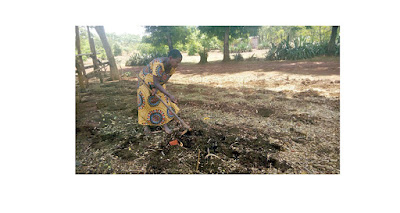It’s planting season in Kasulu district, and Mrs. Ziporah Mussa is in her plot planting beans. The weather is cool and the sun is rising through a few clouds. Mrs. Ziporah says, “I have been growing crops for about 15 years now.… For bean varieties, I grow Lyamungo and Njano in large quantities.”
Mrs. Ziporah lives in Nyumbigwa village, in the Kasulu district of Kigoma region in western Tanzania. She says, “Pests known as butotos in the local Ha language have been affecting beans for the past two seasons. The pest affects all bean varieties.”
She says that chemical pesticides are available in the village, and in Kasulu town about 10 kilometres away. But they are expensive and she doesn’t always buy them.
Sometimes she prefers to use local pesticides. She says that leaves of a tree called ntibuhunwa (Tephrosia vogelii) in the local language help her fight butotos. She explains, “I grind the leaves and mix with ground pepper and then I soak them in water for 24 hours.” She adds, “I also cut and grind the fruits of a plant calledvitembwatembwa, [and] then I put them in water for 24 hours as well.”
After 24 hours, Mrs. Ziporah filters the liquid to use as a pesticide. She explains, “I put the liquid in a 10-litre plastic container and use a soft broom or a tree branch with small, soft leaves to apply [the pesticide] on bean [plants].”
Esther Mpuzu also grows beans in Nyumbigwa village. She says that pests affect almost all the bean varieties in the field, but that a variety called Lyamungo is more resistant to pests and diseases. But, she cautions, if you don’t plant it on time, this variety can also be affected.
She says, “Kalabhutahe has a big impact on maize, and I have seen them in beans too. [But] butotos are the ones [pests] that strongly affect beans.”
Mrs. Mpuzu says that her pest problems began two seasons ago. Before that, she says, beans were not attacked by pests or diseases in her area. She says, “I did not put much effort into overcoming the problem since they just affected a small portion of my farm.”
To manage the pests, she says she “tried to apply the chemical pesticides that I often use on maize. [But] the chemical did not work properly because the pests continued to affect beans.”
Michael J. Sabibi is an extension officer in the area. He says, “I visit farmers regularly to identify the kind of pests and diseases that attack their crops. I advise them how to solve the problem.”
Mr. Sabibi helps farmers understand how to properly apply pesticides at the right time. He continues, “I also advise them to use crop rotation and uproot infected beans so that they cannot spread the problem to uninfected ones.”
He says there are many pests and diseases, but the ones that affect beans most are butotos and Fusarium wilt. He adds, “Most farmers cannot afford to buy chemical pesticides [because they] are expensive.”
However, according to J. J. Rubuye, a regional agricultural advisor in Kigoma Region, part of the reason that farmers say they can’t afford pesticides is that they only consider buying pesticides at the beginning of the season—when they have little cash. If farmers bought pesticides in advance—after selling their harvest—Mr. Rubuye says that the pesticides would be more affordable, and farmers would be able to better manage pests and diseases.
Mr. Sabibi also says that local farmers use the leaves of the ntibuhunwa tree (Tephrosia vogelii). They grind the leaves and soak them in water for some hours, then filter the liquid and apply it to their beans. He adds that there is no clear recommendation on how much of the liquid to use; farmers just apply it when they have problems with beans.
He says, “It seems that local pesticides work because most farmers are using it.”
Mrs. Ziporah agrees that the local pesticides seem to work, though they are easily washed off by rainwater, at which point the pesticides enter local water sources. Like chemical pesticides, some natural pesticides can have adverse affects on fish and other aquatic creatures
This work was created with the support of AGRA, the Alliance for a Green Revolution in Africa, as part of the project, “Integrated project to increase income and improve food security and livelihood among smallholder farmers in the Western Tanzania/ Kigoma region.” The views expressed in this article do not necessarily reflect those of AGRA or any other organization
This work was created with the support of AGRA, the Alliance for a Green Revolution in Africa, as part of the project, “Integrated project to increase income and improve food security and livelihood among smallholder farmers in the Western Tanzania/ Kigoma region.” The views expressed in this article do not necessarily reflect those of AGRA or any other organization









write your comment here